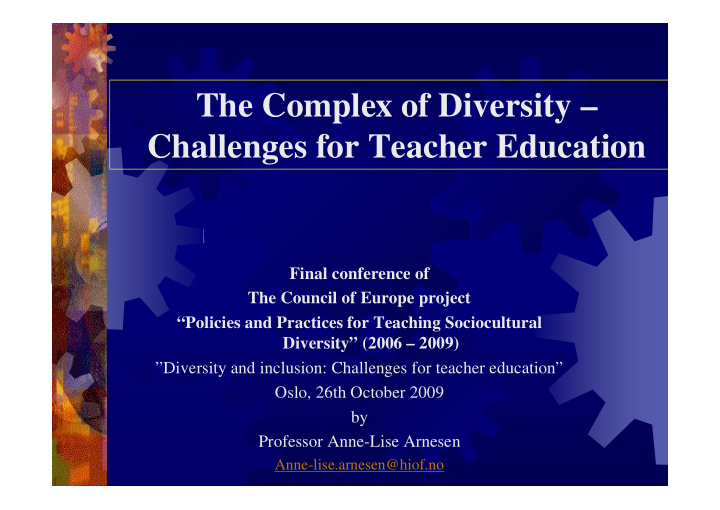



The Complex of Diversity – Challenges for Teacher Education Final conference of The Council of Europe project “Policies and Practices for Teaching Sociocultural Diversity” (2006 – 2009) ”Diversity and inclusion: Challenges for teacher education” Oslo, 26th October 2009 by Professor Anne-Lise Arnesen Anne-lise.arnesen@hiof.no
Diversity
The presentation fi How to understand diversity? fi Critique of the diversity concept fi The complex of diversity fi Diversity in education fi Challenges for teacher education
How can we understand diversity? fi Diversity fi Plurality fi Diversity=Cultural diversity fi A principle underpinning policies fi A concept with multiple connotations and interpretations
Critique of the diversity concept fi A focus on desireable aspects of diversity, obscures the fact that ’differences’ may be a question of inequality fi Based on an economic rationale and human capital thinking fi Reduced focus on equality and social justice fi Simplistic and unreflective use of the concept
Examples of conceptual constructions in current use (Unesco (2005) Guidelines for inclusion)
The complex of diversity fi All kinds of differences: the unique individual fi Socio-cultural diversities fi Visible differences, ”Natural” diversities? fi Structural diversities (in policies): fi Immigrant background fi Cultural and lingual differences fi Religion fi Gender fi Dis/ability fi Other fi Socially and culturally constructed differences fi Diversity based on people’s identity, experiences and common circumstances
Assumptions underpinning diversity fi All human beings are unique, but also complex fi Human beings are socially and culturally shaped fi Diversity in a particular society or cultural context is ordered or structured fi There is an internal plurality within every society or culture fi People are not just being different, but are becoming different through different life circumstances, and social and cultural backgrounds fi People are not just determined by or accepting their circumstances or backgrounds, but also negotiating, confronting, opposing and changing them fi Human beings are not solely characterized by their differences, but also by their similarities
Education as a complex field Education
Education as a contradictory field fi Social welfare and economic motives generally exist side by side in education politics fi Contexts for failure and marginalization fi Elaborated practices of categorization and labelling, e.g. in order to provide certain benefits, special education provisions etc. fi Diversity within specialised discourses: gender, ability, ethnicity, culture, language, class, race, etc.
But……. fi The potential of education as one of the major institutions for enhancing progress and preventing unemployment and social exclusion fi The importance of educational institutions as contexts for children and young people to learn to live together across differences. fi Quality education can mean a difference for those living difficult lives
Challenges for teacher education fi Recognize reality as plural, complex and dynamic fi Teachers are part of that plurality, complexity and dynamic fi Start from within: build up understanding among teacher students about themselves, their circumstances and position in a world of diversity fi Needs shifting the focus from the differences of individuals to the factors which maintain differentiation and discrimination in social life
fi Emphasise the promotion of inclusive environments for all children and young people, recognizing that some are particularly vulnerable and at risk of marginalization or exclusion (engaged pluralism [Maxine Greene] fi Develop in teacher students a sensitivity towards tensions between diversity and unity
Summing up fi Diversity understood in its complexity fi Balance diversity and unity fi Diversity embedded in a social community fi Education fi Teacher education fi ”As teachers and scholars we seek conceptual frameworks to reshape the curriculum so that it will reflect the divers reality of the world and the experience of all children, boys and girls, men and women, able and disable” ( somewhat modified from Judith Butler )
Conclusion fi It has been said that diversity is the fundamental principle that fosters creativity and progress; it is an essential attribute of human development (Pérez de Cuéllar, 1996). fi The statement is seductive, and the notion of celebrating and enhancing diversity has been widely embraced, not least in education policies and in schools. However, a general commitment to diversity raises a number of questions that I have reflected upon in this presentation. In order to work constructively towards the enhancement of a more pluralistic, open and inclusive society, we need to face the complex of diversity in the context of education.
Recommend
More recommend